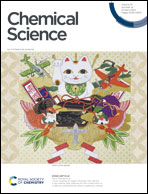Nanoscale solvent organization in metal–organic framework ZIF-8 probed by EPR of flexible β-phosphorylated nitroxides†
Abstract
Metal–organic frameworks (MOFs) draw increasing attention as nanoenvironments for chemical reactions, especially in the field of catalysis. Knowing the specifics of MOF cavities is decisive in many of these cases; yet, obtaining them in situ remains very challenging. We report the first direct assessment of the apparent polarity and solvent organization inside MOF cavities using a dedicated structurally flexible spin probe. A stable β-phosphorylated nitroxide radical was incorporated into the cavities of a prospective MOF ZIF-8 in trace amounts. The spectroscopic properties of this probe depend on local polarity, structuredness, stiffness and cohesive pressure and can be precisely monitored by Electron Paramagnetic Resonance (EPR) spectroscopy. Using this approach, we have demonstrated experimentally that the cavities of bare ZIF-8 are sensed by guest molecules as highly non-polar inside. When various alcohols fill the cavities, remarkable self-organization of solvent molecules is observed leading to a higher apparent polarity in MOFs compared to the corresponding bulk alcohols. Accounting for such nanoorganization phenomena can be crucial for optimization of chemical reactions in MOFs, and the proposed methodology provides unique routes to study MOF cavities inside in situ, thus aiding in their various applications.



 Please wait while we load your content...
Please wait while we load your content...